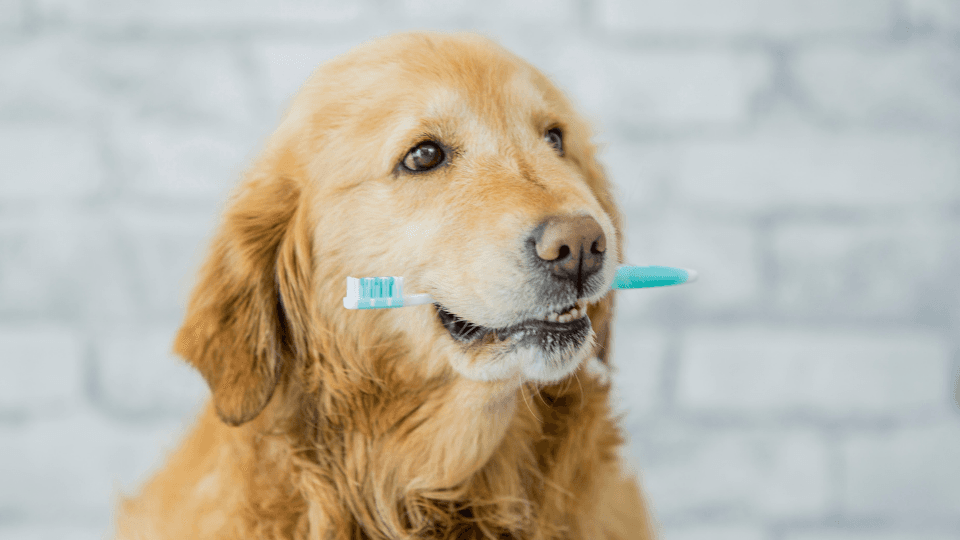Most people know to brush their own teeth everyday, only 4% of people brush their pet’s teeth daily, according to a recent study on dental home care. Doing dogs’ dental work at home can be a great way to save money — if you actually do it. Otherwise, any bit of money you might have saved on pets’ preventive dental care could be spent on more-expensive dentistry work later on down the road.
In this post, we’re discussing the different costs of pet dental care so you can plan ahead just in case. We’ll also go over how pet dental insurance could help offset some of these expenses to make both your pet and your wallet smile.
Table of Contents
- Common pet dental care costs
- Average cost of dental illnesses and injuries in pets
- Saving money with pet dental insurance
- Key Takeaways
Average costs for pet dental care
Typically, the cost for dog teeth cleaning is between $300 and $700. Dog dental cleaning usually involves visual examination of the teeth, gums, and roof of the mouth, x-rays of the mouth, tooth roots, and jaw, removing tartar and plaque buildup, polishing the teeth, and anesthesia. However, what starts out as routine cleaning could cost more if the veterinarian discovers that your pet needs an extraction. Canine tooth extraction costs from $10 to $15, but extractions that involve elevation of each root can cost more, usually up to $25 to $35 per tooth.
Feline veterinary treatments tend to be cheaper than canines’, but cat dental work costs every bit as much as for dogs due to challenges related to cats’ smaller teeth and jaws. Cat owners can expect to pay from up to $1,300 for a tooth extraction that includes anesthesia, X-rays, medication, hospitalization, and surgical supplies.
The cost might go even higher for the most intensive procedures such as root canal surgeries or crowns. In fact, the cost of root canals in dogs and cats is about the same as it is for humans, averaging between $1,500 and $3,000, but in some cases, pet owners can expect to pay even more. For instance, depending on the location, a root canal performed on a large canine tooth can reach up to $6,000 according to Embrace Pet Insurance.
Average cost of dental illnesses and injuries in pets
Gingivitis, calculus, periodontal (gum) disease, and dental fractures are common oral issues among pets.
Periodontal disease, which is largely preventable by tooth brushing, is the most common oral clinical condition in both dogs and cats. This disease can lead to severe health problems, ranging from tooth loss to organ failure. According to the American Veterinary Medical Association, about 80% of dogs and 70% of cats develop some form or degree of periodontal disease by the time they are three years old.
Based on claims to C&F Insurance Agency, it was found that the average pet insurance claim for periodontal disease in dogs between 2017 and 2020 was $1,942. Cat owners, on the other hand, paid on average $768 for the same disease, according to Pets Best.
The cost of tooth fractures that usually result from car accidents, fights, and chewing on hard objects, will vary depending on the breed, the kind of fracture, as well as the treatment selected. Embrace estimates that more complicated fractures that require extraction might cost between $500 and $1,000 for a large tooth if it is extracted by a general practitioner. The price will be significantly higher if extraction is performed by a board-certified dentist. Tooth extraction in cats can range from $300 to $1,300.
Saving money with pet dental insurance
Pet insurance can help keep you out of debt if your four-legged friend experiences dental problems. However, not all pet insurance companies cover expenses resulting from dental issues, which is why it’s important to take a closer look at dental benefits when comparing pet insurance policies.
Coverage varies depending on the company, but there are typically two types of dental coverage: dental illnesses and dental accidents. Companies like Embrace, Trupanion, Pumpkin, Prudent Pet, and Spot cover both dental illness and accidents, and reimburse for various dental issues including teeth removal, damaged teeth, gum disease, stomatitis, gingivitis, and crowns. Other pet insurance providers, such as Lemonade, cover only dental accidents or issues resulting from accidents.
However, there are certain things that no pet insurance plan will cover, such as cosmetic, orthodontic, or endodontic services like fillings, caps, and implants, as well as pre-existing conditions that occurred before the coverage began. Routine teeth cleanings are considered preventative care, so they typically don’t qualify for coverage under traditional accident-and-illness plans. However, most insurers offer add-on wellness plans that can reimburse you for dental cleaning costs.
Be sure to check if the policy has any requirements for making a dental insurance claim. For instance, Pets Best will only cover dental illnesses if the pet is under the age of three and has been examined under general anesthesia within three months of the claim's date of service.
Use Pawlicy Advisor to compare pet insurance plans side-by-side and find the best dental coverage for your pet. You can also use our budgeting template to get prepared for unexpected events and ensure that your four-legged friend gets adequate treatment.
Key Takeaways
- Dental diseases are quite common in dogs and cats, and treating them can be really expensive. Pet parents can expect to pay from $300 to $700 for teeth cleaning, $1,500 to $3,000 for root canals, and about $1,900 for periodontal disease.
- Pet insurance can help cover the expenses related to pet dental issues. However, it should be noted that not all pet insurance plans cover dental treatments, which is why it is important to shop around and carefully compare the details of each policy.
- Pawlicy Advisor allows you to compare leading pet insurance providers and find the best pet insurance policy that covers dental treatments.
